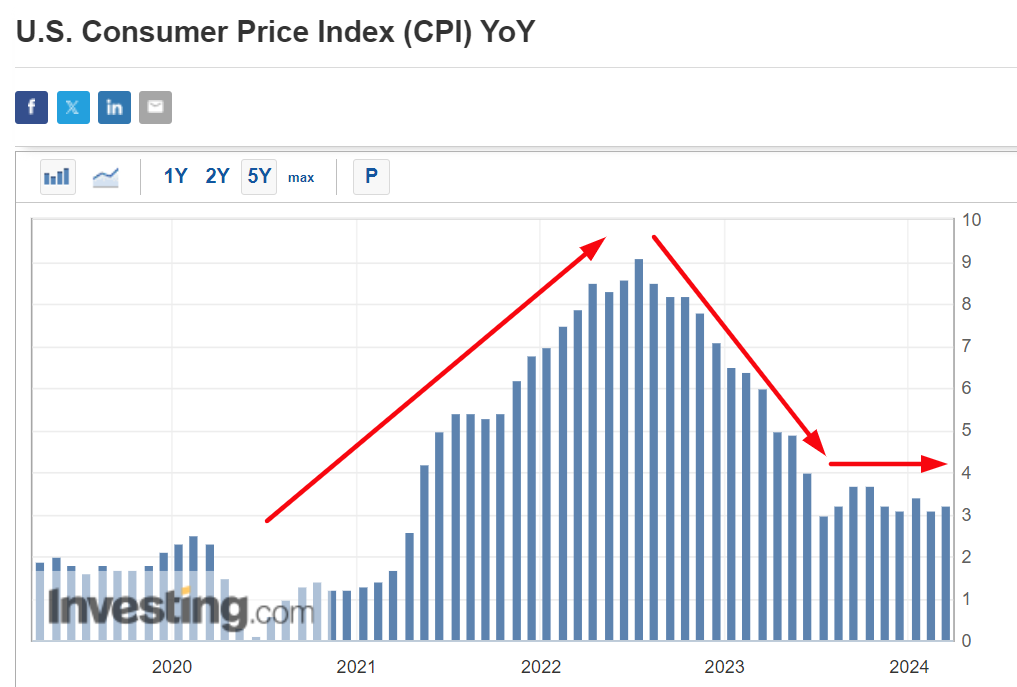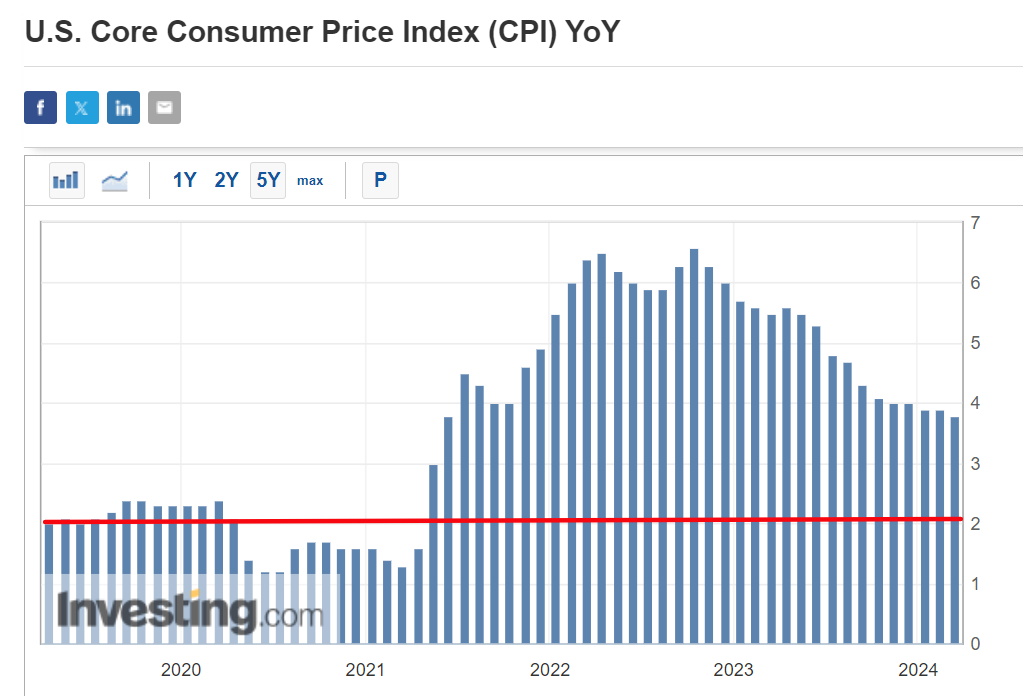- February's CPI report came in hotter than expected for the second straight month.
- Sticky inflation suggests the Fed could delay an anticipated June interest rate cut despite the market’s expectations.
- Easing bets could be pushed out further as there is a growing chance of no rate cuts at all this year.
- Looking for more actionable trade ideas? Join InvestingPro for under $9 a month for a limited time only and never miss another bull market by not knowing which stocks to buy!
Don’t expect the Federal Reserve to cut interest rates anytime soon as sticky inflation seems to be very much intact at this point.
Tuesday’s much-anticipated U.S. February consumer price index (CPI) inflation report came in hotter than expected for the second straight month, providing further evidence that the Fed will be in no rush to start easing monetary policy.
Source: Investing.com
The CPI rose 0.4% last month, marking the largest monthly increase since September. In the 12 months through February, the annual CPI increased 3.2%. That followed a gain of 3.1% in January.
While CPI has come down significantly from a 40-year high of 9.1%, the data confirmed that the decline in inflation that began in the summer of 2022 has all but stalled.
Source: Investing.com
In fact, taking a closer look at the chart above reveals that the headline figure has been stuck in a range between 3.0% and 3.8% for the past eight months, highlighting the challenge faced by the Fed in the ‘last mile’ of its fight against rising prices.
The ‘last mile’, which is often the hardest to bring under control, refers to the final 1% or 2% of excess inflation that the Fed needs to overcome to meet its 2% target.
Excluding the volatile food and energy components, core CPI climbed 0.4% over the prior month and 3.8% over last year. The forecast had been for 0.3% and 3.7%, respectively.
Furthermore, core services inflation excluding rents, a metric to which Fed Chairman Jerome Powell has said he pays close attention, advanced 0.5% in February, and over the past three months is up on an annualized basis by 6.8%, compared with the 6.7% pace in January.
The sticky-hot readings will add to Fed caution on the inflation outlook and suggest that FOMC officials would need to see further progress before they are comfortable cutting interest rates.
Key Takeaway
The Fed’s inflation battle is far from over, with CPI still rising far more quickly than what the Fed would consider consistent with its 2% target range.
Additionally, core inflation is proving stickier than expected and is anticipated to remain well above the Fed’s target for the foreseeable future.
Indeed, this last mile of getting inflation down from 3% to 2% is going to be difficult - much harder than bringing it down from 9% to 3%.
Source: Investing.com
Taking that into consideration, the Fed will be in no rush to lower its key policy rate in my opinion despite market expectations for a June rate cut.
Based on Investing.com’s Fed Monitor Tool, investors are betting the Fed will reduce borrowing costs by about 75 basis points by year-end, delivering three-quarter percentage points of easing in June, September, and December.
But that scenario is probably unrealistic amid the current macroeconomic backdrop.
What's Next?
Contrary to the consensus view, I believe there is a growing risk that the Fed will hold off on cutting rates altogether this year as inflation takes longer to return to the Fed's target than many had hoped, and the economy keeps outperforming expectations.
As such, the central bank is likely to keep interest rates at current levels for longer than investors expect amid sticky inflation, a resilient labor market, and solid consumer spending.
We’ll find out more about the Fed’s rate plans next week.
The U.S. central bank is widely expected to leave its benchmark Fed funds rate in the current 5.25%-5.50% range where it has been since last July.
Perhaps of greater importance, FOMC policymakers will also release updated interest rate projections as part of a so-called dot plot.
At this point, it will be prudent to wonder how many cuts we’re ultimately going to get this year, if at all.
Be sure to check out InvestingPro to stay in sync with the market trend and what it means for your trading.
Readers of this article enjoy an extra 10% discount on the yearly and bi-yearly plans with the coupon codes PROTIPS2024 (yearly) and PROTIPS20242 (bi-yearly).
Subscribe here and never miss a bull market again!

Disclosure: At the time of writing, I am long on the S&P 500, and the Nasdaq 100 via the SPDR S&P 500 ETF (SPY (NYSE:SPY)), and the Invesco QQQ Trust ETF (NASDAQ:QQQ). I am also long on the Technology Select Sector SPDR ETF (NYSE:XLK).
I regularly rebalance my portfolio of individual stocks and ETFs based on ongoing risk assessment of both the macroeconomic environment and companies' financials.
The views discussed in this article are solely the opinion of the author and should not be taken as investment advice.
